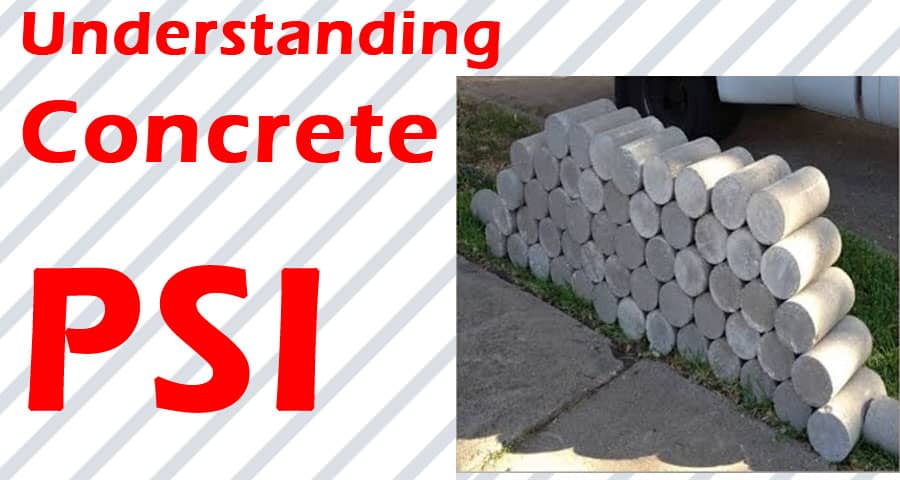Understanding Concrete PSI

Concrete is a fundamental material used in construction, known for its strength and durability. One crucial aspect of concrete quality is its PSI, or pounds per square inch, which measures its compressive strength. Understanding Concrete PSI is essential for ensuring the structural integrity and longevity of various construction projects.
What is PSI?
PSI, or pounds per square inch, is a unit of pressure used to quantify the compressive strength of concrete. It indicates the maximum load that a concrete sample can bear before it fails under compression. Higher PSI values signify stronger and more durable concrete.
Importance of PSI in Concrete
The PSI rating of concrete is a critical factor in determining its suitability for different applications. Whether it's a residential driveway or a high-rise building, the PSI requirement varies based on the anticipated load and environmental conditions. Optimal PSI ensures that the concrete can withstand the intended loads and environmental stresses over its lifespan.
Factors Affecting Concrete PSI
Several factors influence the PSI of concrete:
- Material Composition: The types and proportions of materials used in concrete mixtures directly impact its compressive strength. High-quality aggregates, proper cement content, and supplementary materials like fly ash or silica fume can enhance PSI.
- Water-Cement Ratio: The water-cement ratio plays a significant role in concrete strength. Excess water weakens the concrete matrix, resulting in lower PSI. Maintaining an appropriate water-cement ratio is crucial for achieving the desired compressive strength.
- Curing Conditions: Proper curing is essential for allowing concrete to reach its full PSI potential. Adequate moisture and temperature control during the curing process promote hydration and bonding of cement particles, contributing to higher compressive strength.
Testing Concrete PSI
Accurate testing of concrete PSI is vital to ensure quality control and structural integrity. Various methods are used for testing PSI, including destructive and non-destructive techniques such as compression tests, rebound hammer tests, and ultrasonic pulse velocity tests.
Recommended PSI for Different Applications
The recommended PSI for concrete varies depending on the specific application:
- Residential Construction: For residential projects like driveways, sidewalks, and foundations, a PSI range of 2500 to 3500 is typically sufficient to withstand everyday loads and environmental conditions.
- Commercial Construction: In commercial construction, where heavier loads and higher foot traffic are expected, concrete with a PSI range of 3500 to 5000 or higher may be required to ensure durability and safety.
- Infrastructure Projects: Infrastructure projects such as bridges, dams, and highways often demand concrete with exceptionally high PSI ratings, ranging from 5000 to 7000 or more, to withstand heavy traffic and extreme environmental conditions.
Consequences of Inadequate PSI
Using concrete with inadequate PSI can lead to various structural and safety issues:
- Structural Integrity Issues: Insufficient compressive strength may result in cracking, spalling, or even structural failure, compromising the stability and longevity of the construction project.
- Safety Concerns: Weak concrete poses safety hazards to occupants and users of the structure, increasing the risk of accidents, injuries, and costly repairs.
Strategies for Achieving Optimal PSI
To achieve optimal PSI in concrete, several strategies can be employed:
- Proper Mix Design: Careful selection of materials, precise proportioning, and thorough mix testing are essential for developing concrete mixtures with the desired compressive strength.
- Quality Control Measures: Regular quality control checks throughout the construction process help ensure that concrete batches meet specified PSI requirements and comply with industry standards.
- Effective Curing Techniques: Implementing proper curing techniques, such as moist curing or curing compounds, promotes hydration and strengthens the concrete, resulting in higher PSI values.
Future Trends in Concrete PSI Management
Advancements in concrete technology and sustainability practices are shaping the future of PSI management:
- Innovations in Concrete Technology: Ongoing research and development efforts are focused on creating high-performance concrete mixtures with superior PSI ratings, enhanced durability, and reduced environmental impact.
- Sustainability Considerations: There is growing emphasis on incorporating recycled materials, alternative binders, and carbon-neutral production methods to produce sustainable concrete with comparable or improved PSI properties.
Conclusion
Understanding Concrete PSI is essential for ensuring the quality, safety, and longevity of construction projects. By comprehending the factors influencing PSI, employing appropriate testing methods, and implementing quality control measures, builders can achieve optimal concrete performance and mitigate the risk of structural issues.
FAQs
What does PSI stand for in concrete?
PSI stands for pounds per square inch, a unit of pressure used to measure the compressive strength of concrete.
Why is PSI important in concrete construction?
PSI indicates the concrete's ability to withstand compression and bear loads, ensuring structural integrity and durability.
How is concrete PSI tested?
Concrete PSI is tested using various methods, including compression tests, rebound hammer tests, and ultrasonic pulse velocity tests.
What happens if concrete PSI is too low?
Insufficient PSI can lead to structural issues such as cracking, spalling, and reduced durability, compromising the safety and longevity of the construction project.
How can builders ensure optimal concrete PSI?
Builders can achieve optimal PSI by carefully designing concrete mixes, implementing quality control measures, and employing effective curing techniques.
